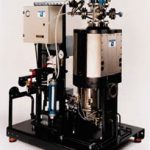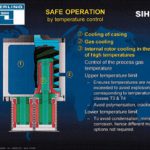The dry running vacuum pump SIHIdry incorporates three cooling loops. These guarantee effective and reliable removal of the compression heat – a typical weakness of dry-running vacuum pumps. As a result, not only can ExT4 conditions be met, but the pump also lends itself to use with any gases that tend to polymerize or degrade at high temperatures.
Over the past few years increasingly stringent environmental laws have caused the costs for disposal or reconditioning of process fluids, as used in the chemical and pharmaceutical industries, to rise – in some cases considerably. For this reason dry-running vacuum pumps have become an attractive alternative, as they require no service liquids. However, when intended for handling explosive gases, or gases with a tendency to polymerize, crack or degrade, they become problematic. Due to the absence of any heat-absorbing fluids, compression heat builds up.
Effective limiting of temperature rise
The dry running vacuum pump SIHIdry incorporates three cooling circuits – the casing, the rotors and the highly effective, internal gas-cooling loop (Fig. 2). These three cooling loops allow the pump to be used even under ExT4 conditions (t135 °C). The pump casing is cooled by means of a cooling jacket, which uses cooling liquid to remove the heat. The rotor cooling system represents an unique design feature. The heat dissipates from the internal rotor surfaces to the bearing cartridges, which in turn are cooled by cooling fluid. This design ensures positive cooling of the rotating displacement screws, which would otherwise tend to undergo a temperature rise corresponding to the compression heat of the gas.
The internal gas cooling system uses cooled gas that is introduced into the compression chamber before the latter opens into the discharge. It compresses the gas while reducing the compression temperature at the same time. Temperature sensors monitor the critical temperature. In case the three cooling systems fail to keep the temperature below the permissible level, the pump speed is lowered to ensure that excessive temperatures are avoided. The temperature of the cooling liquid can be adjusted individually. Should the handled gas contain any vapours which may condense, leading to a risk of corrosion, the temperature of the cooling liquid can be increased to a level that permits condensation to be avoided on the internal pump surfaces.
Principle of operation
The principle of operation is simple. Two vertically arranged displacement screws, turning in opposite directions without touching one another inside the pump casing, transport the gas from the inlet (at the top) to the discharge (at the bottom). There is no internal compression with isochoric displacement screws perform no internal compres-sion. The compression is brought about entirely by the discharge pressure. Polytropic screws compress the gas internally. Both screw configurations can handle liquids. The liquid handling capability of polytropic screws is reduced to 40%, whereas the isochoric rotor can handle 100% liquid.
The two displacement screws are driven by two individual, water-cooled motors mounted inside the pump casing. Purge gas prevents process gas from entering into the motor space. The shafts carry both the motor rotors and the displacement screws. They are supported by two bearings mounted on cartridges. No couplings are used and no shaft seals are required – a feature which enables maintenance costs to be reduced considerably. The pump can operate for 20,000 h without maintenance. Both bearings are exposed to the purge gas to avoid any life-reducing contact with the process gas. Throttling rings between the motor casing and the pump discharge chamber keep the purge gas consumption to a minimum. The pump is hermetically sealed and therefore suitable for all toxic or odorous gases.
For inspection or cleaning purposes the pump casing can be lifted off after undoing a few bolts. All surfaces exposed to the process are then visible for inspection and cleaning. No clearance adjustments are necessary for reassembly.
The two displacement screws are synchronized by means of electronic controls via frequency converters (Fig. 3). A set of emergency gears, which normally operates without contact and without any lubricant, ensures that no contact occurs between the displacement screws in case of an uncontrolled shut-down of the pump.
The electronic speed control system is used to regulate the pump inlet pressure in place of a bypass control loop. There is thus no expenditure on a controller, valves and lines and power consumption costs are cut, as during phases with a low gas flow the pump speed is slowed down in order to reduce the power demand. If the processes require slow augmentation of the vacuum for product quality reasons or to avoid foaming and carry-over of the product into the pump, causing product deposition and build-up on the internal surfaces, the vacuum cycle can be pre-programmed. Operational problems of this nature can thus be prevented.
The electronic speed control system also monitors the internal clearances of the pump. If product builds up, this will be indicated, enabling the operating personnel to take preventive action.
Silent and powerful
The noise development of the dry running vacuum pump SIHIdry is low ( 75 dbA). It is available in EExp class (explosion-proof). A PTB-approved purge gas supply unit controls the purge gas supply. The electronic controls need to be installed in the electrical control room in this case. SIHIdry pumps reach vacuum levels of up to 10-2 mbar and suction flows of up to 750 m³/h. The pump casing is hydrotested at 16 bar test pressure.
Sterling SIHI
Fax: ++49/4821/771-274
Further information cpp 237
SIHI-Halberg now belongs 100% to the Sterling Group. What have been the consequences of this takeover for your corporate structure and market presence?
Mohrdieck: The full integration of SIHI has significantly strengthened the position of the Sterling Group as one of the world’s leading suppliers of pumps. Our customers will benefit to an even greater extent not only from this strategic expansion of the range of products and services in core areas, but also from the additional sales presence on the global markets and the synergy effects that have been set in motion in research and development.
The SIHIdry vacuum pump was first presented to a trade audience at the Achema 97. What reactions to your new product have you so far received from users in the chemical industry?
Mohrdieck: The echo has been extremely positive. This is undoubtedly due to the fact that we designed the SIHIdry pumps not just for the chemical industry, but also in collaboration with it. Its special needs – both commercial and technical – have been taken into account in all aspects of the development. Even the test pumps installed to date have far exceeded users’ expectations. This is equally true for those customers who normally use dry-running pumps from other manufacturers.
Where do you see the future trends in the field of dry-running vacuum pumps?
Mohrdieck: The concept of the SIHIdry pumps has set new benchmarks in R&D. This combination of a simple, mechanical pumping technique and an intelligent driving and monitoring principle is a pioneering development that will open up numerous new opportunities for users of vacuum pumps. Other pump manufacturers will follow this trend towards integrated systems in a variety of ways.
Unsere Webinar-Empfehlung
Der Webcast MTP und modulare Produktion bietet eine einzigartige Gelegenheit, mehr über die aktuellen Entwicklungen bei MTP und in der modularen Produktion zu erfahren.
Chemie- und Pharmaproduktion braucht mehr Flexibilität
In der heutigen sich schnell wandelnden Welt stehen…
Teilen:














